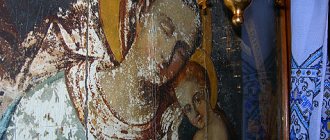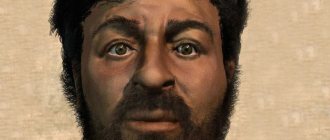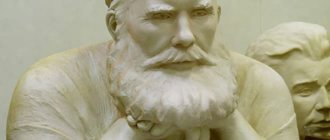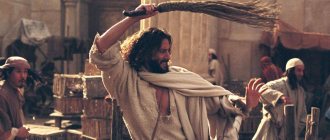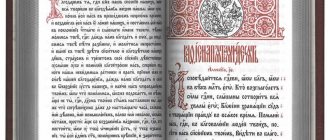Why was Yeshua a carpenter?
Telegram channel @ieshua.org
It is interesting that Yeshua was a carpenter (according to Mark 6:3 [1]), and not, say, a fisherman. The Bible says that He began His ministry when He was thirty years old, and it becomes even more interesting when you look at the professions of many biblical heroes before they began their ministry.
Think about what these biblical heroes were doing when God called them:
David was a shepherd, tending sheep. He killed wild beasts to protect his flock, provided for his sheep, cared for them, fought for them, and much more. It was the perfect metaphor for his calling.
The disciples were found fishing (many of them, anyway), and Yeshua called them to the lifestyle of “fishers of men.” Stories of supernatural fish catches are a great illustration of the thousands of people who would come to faith as they preached the gospel.
Gideon winnowed the wheat, separating the grain from the straw. Isn't it amazing when we think about what he did next? How God forced him to sift the “wheat” from the “straw” in his army through various trials recorded in Judges 8. Through Gideon, God also sifted through the enemies of the people of Israel.
Elisha was busy plowing the field when Elijah came to call him to serve. Yeshua used the image of the farmer as a metaphor for those who would give their lives to serve Him, warning us not to look back. The plow, moving mountains, sprouting seeds, watering and growing are all illustrations of service.
In general, the examples are clear. So what about Yeshua as a carpenter?
Yeshua worked with wood
In the Bible, trees typically represent people—human existence. We can see this in Psalms 1, 91, Isaiah 61 and many, many other texts. We also see that wood represents our humanity, the Bible describes sinful man as a log snatched from the flame by a merciful God.
“...is he not a brand plucked from the fire? Jesus was dressed in filthy robes and stood before the angel, who answered and said to those standing before him, “Take off his filthy robes.” And he said to him: look, I have taken away your guilt and clothed you in ceremonial robes.” (Zechariah 3:2-4)
“You were snatched like a brand from the fire, and yet for all this you did not turn to Me, says the Lord.” (Amos 4:11)
We are mortal, perishable, weak and perishable. We do not remain like stones for centuries, but we rot or burn. It is therefore especially interesting that Yeshua worked with wood, turning rough planks into valuable tools, objects and boats. He put the parts together, polished them, cut off unnecessary parts...
But there is something even more interesting.
Yeshua was born in a manger
At Christmas we reflect on the significance of the fact that Almighty God visited His people. He was clothed in flesh and placed like a baby in a wooden box usually associated with feeding. The Bread of Life was born and placed in a wooden manger - the tree symbolizing his humanity - and all this took place in the city of Bethlehem, which means "house of bread". Don't tell me God didn't think this through! It's amazing.
Yeshua was hanged on a tree
He was crucified on a wooden cross. They nailed him to him so that he could die. The tree is a symbol of our finite, mortal humanity, destined for destruction and death. Here, on these wooden beams, Yeshua puts Himself to death. When He died on the cross and rose again, the power of death itself was defeated. And then He rolled away the stone. Yeshua Himself is likened to a stone in several passages, such as Daniel 2:31-45 and 1 Peter 2:4-5. The tablets of stone, with God's commands and expectations imprinted, set God's standard: "Be holy, for I am Holy." Approaching a Holy God when we have not met His standard of righteousness leads to inevitable judgment. The stone represents the Almighty, unchangeable and irresistible God. Our rock. But Yeshua, God incarnate, places death on the wooden cross and removes the stone of God's righteous judgment. Now the way to return to the Father is open.
Foretold in the Tabernacle
All this was foreshadowed in the Tabernacle, in the book of Exodus. The Ark of the Covenant, in which God chose to dwell, was also made of wood, but covered with gold. What wood? From acacia. These are thorny trees that grow in the desert and are very poor for making anything. In the Bible, thorns and thorns represent sinful people, but this is what God has ordained. He chose to live in us, prickly, sharp, sinful people, made from worthless, cut down trees, cut off from the source of life. The ark was covered with gold, representing God's holiness and righteousness that covers us, blood-bought in the place of mercy. This is exactly where He chose to make His home.
“Whoever’s work is burned will suffer loss; however, he himself will be saved, but as if from fire. Do you not know that you are the temple of God, and the Spirit of God lives in you? If anyone destroys the temple of God, God will punish him: for the temple of God is holy; and this temple is you" (1 Corinthians 3:15-17)
So when you think of Yeshua as a helpless child placed in that wooden manger, or as our beautiful Savior hanging on that tree for our sins, know that it is all planned. All this was calculated, taken into account and agreed upon, because He wanted to live in communion with us, with His frail friends. And in gratitude, allow Yeshua the carpenter to transform you into a tool, a vessel that can be used for good according to His perfect wisdom. He decided to come to your house and live in you. The mighty power that was in that manger, the Spirit of Yeshua, lives in you. And who knows what you will be called for?!
[1] Mark 6:3, which says Yeshua was a carpenter, and Matthew 16:55, which says He was the son of a carpenter, use the Greek word tekton. This word means more than just a person working with wood, it means “master” or “craftsman.” The reason it is translated as carpenter is because very early texts show that Yeshua was known for working with wood.
Justin Martyr (100-165 AD) wrote in the Dialogue with Tryphon the Jew, chapter 88: “But when Jesus came to the Jordan, and He was considered the son of Joseph the carpenter, and He seemed, as the Scriptures foretold, without form and was We take him for a carpenter (for He, living among people, was engaged in carpentry work, made plowshares and yokes, and thereby taught righteousness and an active life).” This was written just 100 years after the death of Jesus. Likewise, the second-century apocrypha, the Gospel of Thomas, describes Yeshua making plows and clamps from wood. (Greek Text A, Chapter VIII). Although the second text cannot be relied upon in its entirety, it helps to see that from the early years after Yeshua's death, stories about Him from more than one source spoke of Him as a craftsman who worked with wood.
Source - oneforisrael.org Translation - Tatyana Shtanko for
Donate Last: 07/05. Thank you!
Subscribe: Telegram • Facebook • • • Twitter • Instagram • Youtube
More on the topic:
- The deep meaning of the name Emmanuel
- A small word with a big meaning
- A striking detail in the story of Joseph that no one notices
- This simple question is your key to living with God.
Biography of Jesus Christ
Jesus Christ is the central figure in the Christian faith. For Christians, this person is the King of the world, one of the hypostases of God, the Savior who appeared in the flesh and atoned for the sins of people.
Image of Jesus Christ
The Bible says that he was a perfect, sinless, immaculately conceived God-man, a miracle worker, a healer, the head of the Kingdom of God he created, the Church, the founder and main character of a religious cult, who died, was crucified on the cross, and then resurrected. At the end of time, he will return to judge the world, after which all the saved will live and rejoice on Earth forever.
His life path and purpose are set out in the Gospels. In Islam he is recognized as a prophet, one of the messengers of Allah, in Judaism he is referred to as the False Messiah (since in the holy book of the Torah, one of the signs of the coming of the true Messiah is the end of all wars, the disappearance of evil and crime).
About the role of women
It’s no secret that Judaism was a somewhat misogynistic religion; women remained second-class characters. However, in the community of Jesus we see the opposite. The apostles were married, but in addition to this, there were independent women in the community, disciples of Jesus. Mary and Martha are widely known, but there were others. For example, an important person was Joanna, the wife of Chuz, the housekeeper of King Herod Antipas.
“It should be understood that Khuz is not a housekeeper, but a minister of state property, a major official at the court of Antipas, and the fact that his wife is connected with the community of Jesus is even strange,” Mikhailov emphasizes. “Perhaps this can explain where the community gets its money.” After all, one of the wealthy women could act as a sponsor. The community lived modestly, and what for Khuz’s wife was pennies “for pins” amounted to a subsistence amount for the community.
Personal life
According to recent scientific research, which was picked up by writer Dan Brown, Jesus Christ was married. The discovered papyrus fragment with text mentions his wife Mary. Most historians agree that it is about the girl Mary Magdalene, who came from Magdala, which was located on the shores of Lake Gennesaret.
Meeting of Mary Magdalene and Jesus Christ
If we consider the non-canonical Gospel of Philip, written in the 3rd century AD, its text indicates that Jesus and Mary were “koinonos”. This word can be translated from ancient Greek as “partner,” which means that in this case both a spiritual and physical connection could be implied. This apocryphal text also stated that Jesus “kissed the lips” of Magdalene.
Jesus Christ and Mary Magdalene
After the execution on Golgotha, Mary stood with the Mother of God at the cross, and early in the morning she came to the tomb of Jesus to anoint his body with myrrh (fragrant oil). However, the angel reported that Christ had risen. She ran to tell the Apostle Peter about what had happened, thinking that someone had stolen the body, but when she returned, she saw the Savior of the world, who announced to her that he was ascending to the Father.
Immaculate Conception
No one sets out to refute or prove the idea of the virgin birth. However, neither the Evangelist Mark, nor Paul, nor even John write anything about this, and the Apostle Paul says that Jesus was the seed of David according to the flesh, that is, in the male line he descended from King David. In addition, as researchers say, the Jews did not have the idea of vicious conception at all.
“Most likely, this idea arose later, in the 60-70s of the first century, when the bulk of the early Christian community began to be formed by former pagans,” says the religious scholar. “They understood that unusual heroes must be born in unusual ways. For example, they talked about the immaculate conception of Plato and Octavian Augustus, the emperor during whom Christ was born. Moreover, August’s parents were well known.
Excellent speaker
At the age of about thirty, Jesus begins to preach sermons. And here the most ardent skeptic will not be able to refute: he was an excellent speaker, attracting up to five thousand people to his sermons. At that time, it was the same as putting together an “Olympic”: taking into account that there were no means of amplifying the sound and more people simply would not have heard anything. In addition, Jesus was also an outstanding healer.
The critical approach of scientists assumes that all miracles need to be explained or refuted. However, the explanation of some miracles is no less beautiful than the miracles themselves. An example is when Jesus feeds a large crowd of people gathered with five loaves of bread and two fish. Religious scholars believe that we are witnessing a “miracle of human generosity”: there was a long sermon, everyone was tired, and Jesus took out his food and shared it with the people. At that moment, the others, touched by his action, remembered that they had brought food with them for the picnic and also began to share. The writer Varlam Shalamov interpreted the miracle approximately in this vein.
Was the historical Christ born before Christmas?
The unknown continues. It seems that everyone knows when Jesus was born: after all, we count our era from the Nativity of Christ. However, we do not know the exact date. Evangelists write that Jesus was born during the reign of Herod the Great. Then, taking into account that Herod died in 4 BC, we get that Jesus was born before the Nativity of Christ, oddly enough. The Gospel also reports that Jesus was born during the Roman census of Judea. But the only census that is suitable in time dates back to 5-6 AD. Then it turns out that Jesus was born after Christmas.
True, historians still suggest that Jesus was born during the reign of Herod the Great, that is, no later than 4 years BC.
Now regarding the date of birth. It’s also difficult with it, because scientists are not sure that it is December 24-25, as is commonly believed. It is known that early Christians celebrated the birth of Jesus in April and May, and subsequently adopted Roman dates: at the end of December the Romans celebrated the key holiday of the cult of the Invincible Sun. Christians also liked the idea of the Invincible Light triumphing over darkness, so, most likely, they tied the birth of Jesus to these days.
The same with the end of earthly life. We know that this is the middle of Passover, the middle of the month of Nissan, but how long Jesus lived is a mystery. It seems to be really 33 years, but nowhere in the New Testament does it say this.

